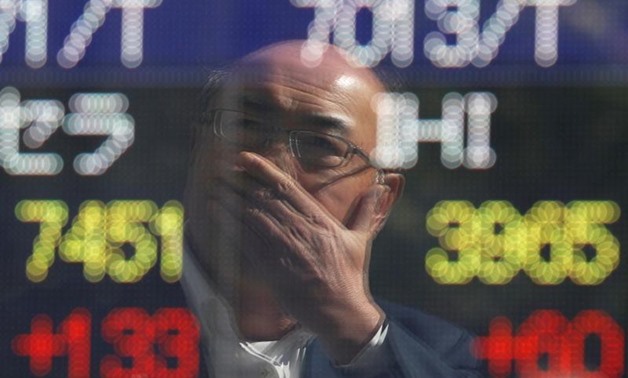
A man is reflected in an electronic stock quotation board outside a brokerage in Tokyo, Japan, October 23, 2017. REUTERS/Issei Kato/File Photo
TOKYO - 6 December 2017: Asian stocks slipped across the board on Wednesday as various factors including weaker metals prices and monetary policy concerns in China soured investor risk sentiment.
Spreadbetters saw bearish equity sentiment extending into Europe, predicting Britain's FTSE .FTSE would open 0.5 percent lower, seeing Germany's DAX .GDAXI start down 0.6 percent and France's CAC .FCHI opening 0.5 percent lower.
MSCI’s broadest index of Asia-Pacific shares outside Japan .MIAPJ0000PUS dropped to a two-month low and was last down 1.5 percent.
The index took early cues from overnight losses on Wall Street, where the stuttering technology sector had taken a further toll.
The fall in the index deepened as Asia's equity markets suffered losses, with Shanghai stocks .SSEC falling to three-month lows and Hong Kong's Hang Seng .HSI dropping to a one-month trough amid fears over central banks tightening liquidity. [.SS]
Japan's Nikkei .N225 was last down 2 percent with non-ferrous metals producers .INFRO.T suffering large losses after copper's slide overnight to a two-month low.
Perceived geopolitical risks also dented confidence with U.S. President Donald Trump due to recognize Jerusalem as the capital of Israel later on Wednesday.
In the debt markets, the two-year Treasury yield US2YT=RR hovered near a nine-year high, elevated by the Fed’s tighter policy path and on expectations the U.S. Congress will pass tax reform legislation that gives the economy a fiscal boost.
But the 10-year Treasury yield US10YT=RR declined, flattening the yield curve further. The curve has flattened as investors see limited room for long-term U.S. inflation.
The dollar fell, weighed by lower long-term U.S. yields as broader investor risk appetite recedes. The dollar index against six major currencies slipped 0.2 percent to 93.213 .DXY.
The greenback lost 0.4 percent to 112.110 yen JPY= and the euro rose 0.15 percent to $1.1842 EUR= after shedding 0.35 percent the previous day.
The pound stood at $1.3426 GBP=D3 for a loss of 0.1 percent, having taken a small knock after Sky News reported of a foiled plot to assassinate British Prime Minister Theresa May.
Sterling had fallen to as low as $1.3370 on Tuesday on disappointment after May failed to clinch a deal to open talks on post-Brexit free trade with the European Union. [GBP/]
Bitcoin continued its relentless advance, climbing to a fresh record high of $12,205.46 on the BitStamp exchange BTC=BTSP. Its latest rise took bitcoin's gains so far in 2017 above 1,100 percent.
“It took a long time to establish the methodology and the way bitcoin was traded. The original appeal came from the fact they were unregulated. However it’s clearly moved out of those shadows and into center stage,” said Mick McCarthy, CMC Markets’ chief market strategist in Sydney.
“We are in the throes of a bubble market, and one of the characteristics of a bubble market is that there is no way to know when the bubble will burst.”
In commodities, U.S. crude oil futures CLc1 were down 0.4 percent at $57.38 per barrel after American Petroleum Institute data showed that U.S. gasoline stocks and distillate inventories rose more than expected last week. [O/R]
Brent crude LCOc1 lost 0.4 percent to $62.62 per barrel, though it is up by over 40 percent since June, supported by a supply cut led by OPEC and Russia which is expected to last throughout 2018.
Copper on the London Metal Exchange CMCU3 crawled up 0.35 percent to $6,565.50 per tonne after sliding to a two-month low of $6,507.50 overnight.
Base metals were hit by a combination of the dollar’s rise earlier in the week on U.S. tax reform hopes, jitters over demand in major consumer China and a technical sell-off stemming from a rise in inventories.

Comments
Leave a Comment